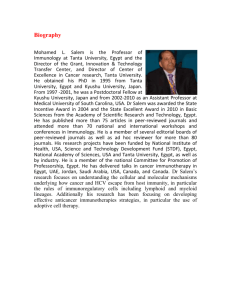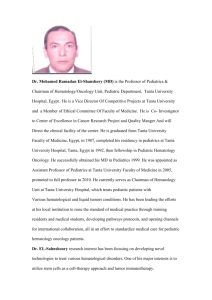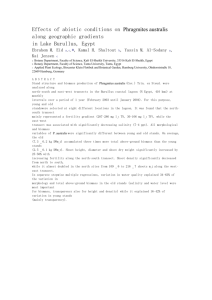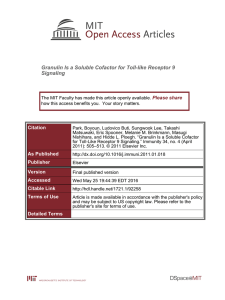significant md
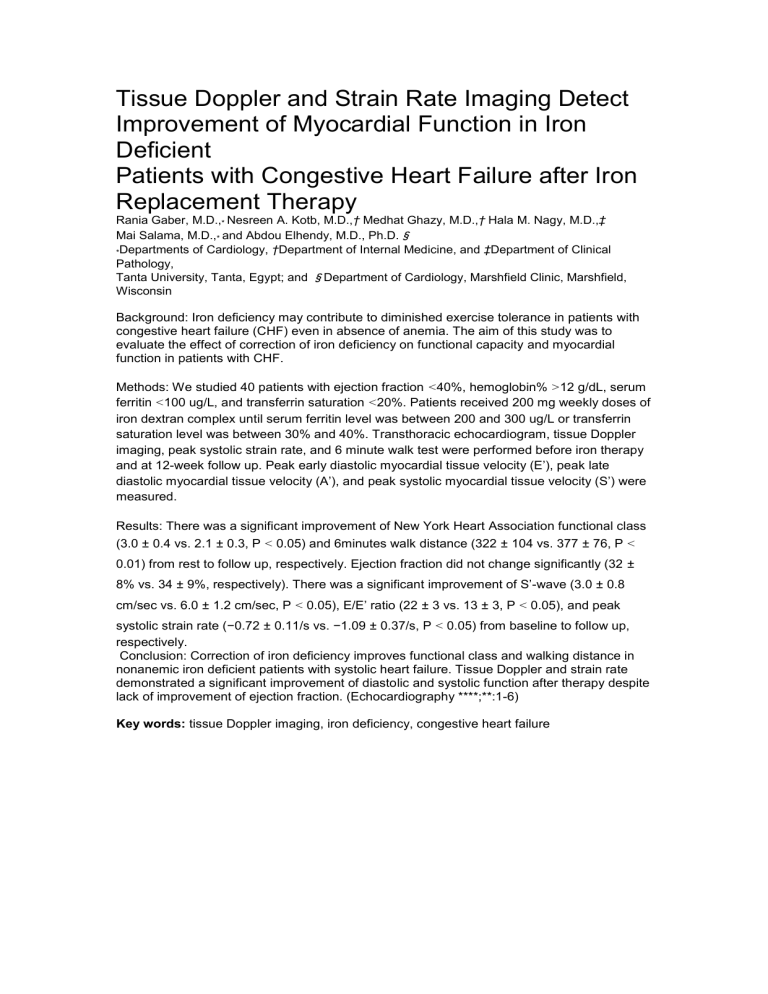
Tissue Doppler and Strain Rate Imaging Detect
Improvement of Myocardial Function in Iron
Deficient
Patients with Congestive Heart Failure after Iron
Replacement Therapy
Rania Gaber, M.D., ∗ Nesreen A. Kotb, M.D.,
†
Medhat Ghazy, M.D.,
†
Hala M. Nagy, M.D.,
‡
Mai Salama, M.D., ∗ and Abdou Elhendy, M.D., Ph.D.
§
∗ Departments of Cardiology,
†
Department of Internal Medicine, and
‡
Department of Clinical
Pathology,
Tanta University, Tanta, Egypt; and
§
Department of Cardiology, Marshfield Clinic, Marshfield,
Wisconsin
Background: Iron deficiency may contribute to diminished exercise tolerance in patients with congestive heart failure (CHF) even in absence of anemia. The aim of this study was to evaluate the effect of correction of iron deficiency on functional capacity and myocardial function in patients with CHF.
Methods: We studied 40 patients with ejection fraction < 40%, hemoglobin% > 12 g/dL, serum ferritin < 100 ug/L, and transferrin saturation < 20%. Patients received 200 mg weekly doses of iron dextran complex until serum ferritin level was between 200 and 300 ug/L or transferrin saturation level was between 30% and 40%. Transthoracic echocardiogram, tissue Doppler imaging, peak systolic strain rate, and 6 minute walk test were performed before iron therapy and at 12week follow up. Peak early diastolic myocardial tissue velocity (E’), peak late diastolic myocardial tissue velocity (A’), and peak systolic myocardial tissue velocity (S’) were measured.
Results: There was a significant improvement of New York Heart Association functional class
(3.0
±
0.4 vs. 2.1
±
0.3, P < 0.05) and 6minutes walk distance (322
±
104 vs. 377
±
76, P <
0.01) from rest to follow up, respectively. Ejection fraction did not change significantly (32
±
8% vs. 34
± 9%, respectively). There was a significant improvement of S’-wave (3.0 ±
0.8 cm/sec vs. 6.0
±
1.2 cm/sec, P < 0.05), E/E’ ratio (22 ±
3 vs. 13
±
3, P < 0.05), and peak systolic strain rate (
−
0.72
±
0.11/s vs.
−
1.09
±
0.37/s, P < 0.05) from baseline to follow up, respectively.
Conclusion: Correction of iron deficiency improves functional class and walking distance in nonanemic iron deficient patients with systolic heart failure. Tissue Doppler and strain rate demonstrated a significant improvement of diastolic and systolic function after therapy despite lack of improvement of ejection fraction. (Echocardiography ****;**:1-6)
Key words: tissue Doppler imaging, iron deficiency, congestive heart failure
The role of chemokine CC ligand 20 in patients with liver cirrhosis and hepatocellular carcinoma
Hanan H. Soliman
1
, Hala Nagy
2
, Nesreen Kotb
3
, Mohamed A. Alm El-Din
4
1
Department Tropical Medicine and Infectious Diseases, Tanta Faculty of Medicine, Tanta -
Egypt
2
Department Clinical Pathology, Tanta Faculty of Medicine, Tanta - Egypt
3
Department Internal Medicine, Tanta Faculty of Medicine, Tanta - Egypt
4
Department Clinical Oncology, Tanta Faculty of Medicine, Tanta - Egypt
ABSTRACT
Background and aim: To evaluate the role of chemokine CC ligand 20 (CCL20) as a biomarker for hepatocellular carcinoma (HCC).
Patients and methods: Ninety patients in four groups were enrolled in this prospective cross-sectional study: 30 with HCC (group I), 30 with liver cirrhosis (group II), 15 with hepatitis C virus infection (group III), and 15 healthy blood donors as controls. Alpha fetoprotein (AFP), CCL20 and vascular endothelial growth factor (VEGF) were measured in all groups.
Results: Serum levels of CCL20 were significantly different among the study groups
(F=230.979, p<0.001). The highest level was found in HCC patients (57.305 ± 6.386 pg/mL) followed by patients with cirrhosis (45.999 ± 5.165 pg/mL) compared with 22.781 ± 5.986 pg/mL and 18.585 ± 3.554 pg/mL in asymptomatic patients with HCV infection and controls, respectively. In HCC patients, CCL20 significantly correlated with VEGF (r=0.559, p=0.001),
AFP (r=0.814, p<0.001), Child score (r=0.748, p<0.001), and tumor size (r=0.825, p<0.001).
The cutoff value of CCL20 for the detection of HCC in HCV-infected patients was 54 pg/mL with 93.1% accuracy, 89.6% negative predictive value, 92.6% positive predictive value,
83.3% sensitivity, and 93.3% specificity. In patients with cirrhosis, CCL20 significantly correlated with VEGF (r=0.455, p=0.011), AFP (r=0.975, p<0.001), and Child score (r=0.977, p<0.001).
Conclusion: CCL20 may be used for the detection of HCC in HCV-infected patients with comparable specificity and higher sensitivity than AFP.
Toll-like receptor 9 in systemic lupus erythematosus, impact on glucocorticoid treatment
Posted online on August 5, 2012. (doi:10.3109/09546634.2012.697110)
Nahla R. Ghaly 1 , Nesreen A. Kotb 2 , Hala M Nagy 3 & El Sayed M Rageh 4
1 Tanta University, Faculty of Medicine, Dermatology & Venereology,
Tanta, Egypt . 2 Tanta University, Faculty of Medicine, Internal Medicine, Tanta
, Egypt . 3 Tanta Unversity, Faculty of Medicine, Clinical Pathology, Tanta
, Egypt .
4 Tanta University, Faculty of Medicine, Physical Medicine, Rheumatolgy and Rehabilitaion,
Tanta, Egypt
Aim : To assess TLR9 expression in systemic lupus erythematosus (SLE) patients, its correlation with disease activity, and impact of TLR9 expression on the response to oral glucocorticoids
. Methods : Twenty-five active SLE, 15 inactive, and 15 control subjects were included. Anti-
DNA, ANA, C3, C4, and TLR9 mRNA expressions were assessed. Active SLE patients only received oral steroid for 6 weeks. Post therapy, they were classified into steroid sensitive and steroid resistant.
Data were reassessed after treatment.
Results : SLEDAI, anti-DNA, ANA, and TLR9 expressions were significantly higher in active
SLE patients. Based on retrograde analysis, TLR9 expression was significantly higher in steroidresistant versus steroid-sensitive group before treatment, with no significant difference between them after treatment. There was a significant positive correlation between TLR9 expression and SLEDAI score and anti-DNA and negative correlation with C3 and C4 in all patients.
Conclusion: TLR9 may play a role in the pathogenesis of SLE and correlates with the disease activity. Corticosteroids have no effect on TLR9 expression, explaining lack of corticosteroid response in some SLE patients. TLR 9 expression can be used in predicting glucocorticoid response in active SLE patients. New treatment modalities targeting TLR9 expression may be of value in steroid-resistant patients.
Clinical and biochemical predictors of increased carotid intima-media thickness in overweight and obese adolescents with type 2 diabetes
Nesreen A Kotb , Rania Gaber , Mai Salama , Hala M Nagy , Abdou Elhendy
Objective: To identify the clinical parameters associated with increased carotid intima-media thickness (CIMT) in overweight and obese adolescents with type 2 diabetes.
Methods: We studied 27 patients (11 males) with type 2 diabetes.
Criteria for selection were age (12
–19 years), body mass index above the
95th percentile for age and gender, a positive family history of diabetes, normal or high C-peptide, and negative studies for islet cell antibodies. Age- and gender-matched healthy subjects were selected as the control group.
Measurements of CIMT, lipid profile, hypersensitive C-reactive protein, hemoglobin A1C (HbA1C), and insulin resistance by homeostasis model of assessment (HOMA) were obtained for all participants.
Results: CIMT was higher in diabetic patients than in healthy subjects
(0.68 ± 0.16 vs. 0.58 ± 0.1, p < 0.01). The range of HbA1C in the 15 patients with uncontrolled diabetes was 7.6
–10.4 (mean: 8.9 ± 0.9). CIMT,
HbA1C, systolic blood pressure, triglycerides, HOMA, and C-reactive protein were significantly higher in patients with uncontrolled than with controlled diabetes. In diabetic patients, CIMT correlated positively with body mass index (p < 0.001), duration of diabetes (p < 0.001), systolic (p < 0.001) and diastolic blood pressure (p < 0.01), HbA1C (p < 0.001), HOMA (p <
0.01), and C-reactive protein (p < 0.01).
Conclusions: CIMT is increased in adolescents with type 2 diabetes.
Poor glycemic control, HOMA, increased C-reactive protein, body mass index, duration of diabetes, and elevated blood pressure are associated with early atherosclerosis in these patients.
Journal: Diabetes & Vascular Disease Research - DIABETES VASC DIS
RES , vol. 9, no. 1, pp. 35-41, 2012
DOI: 10.1177/1479164111421804
